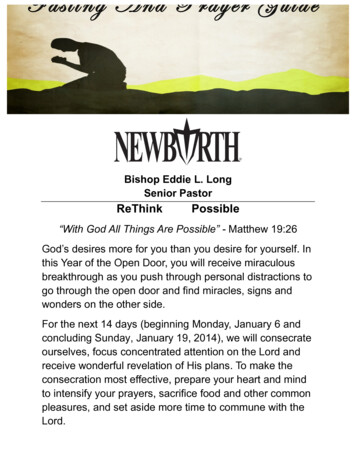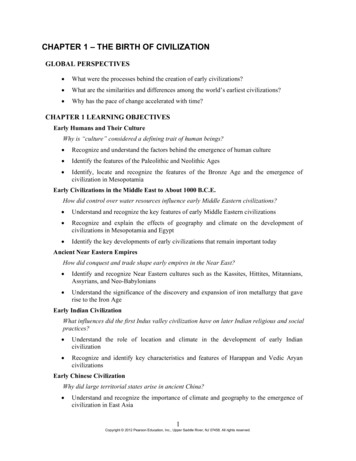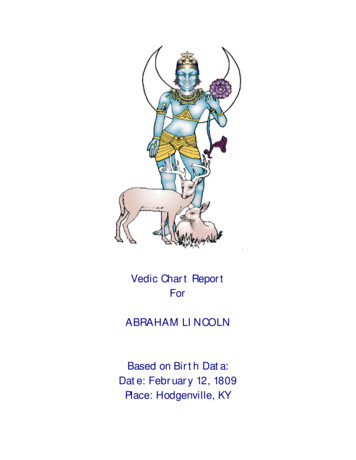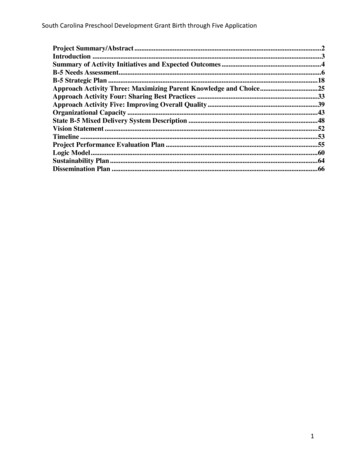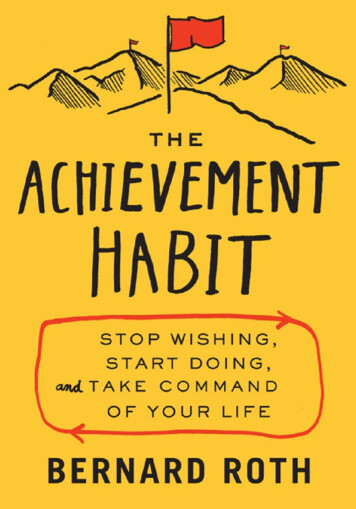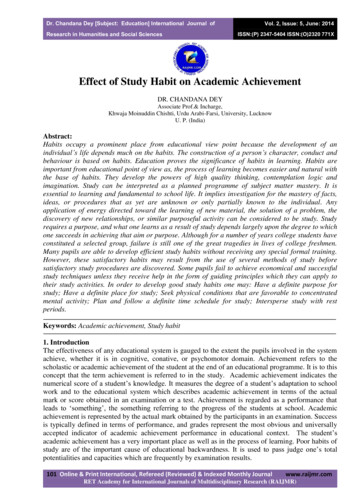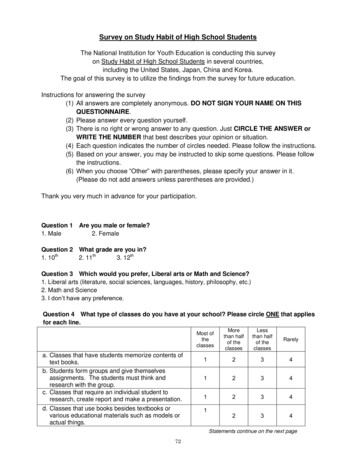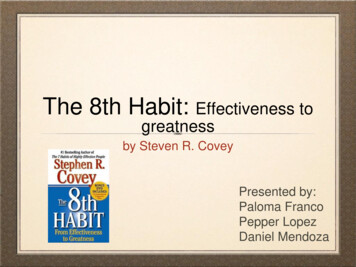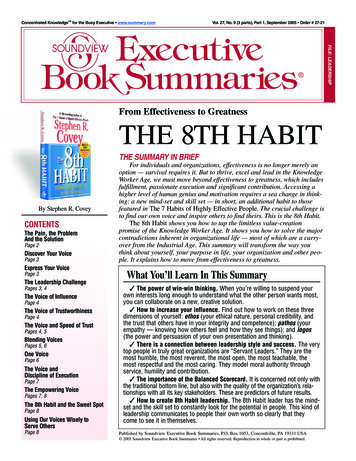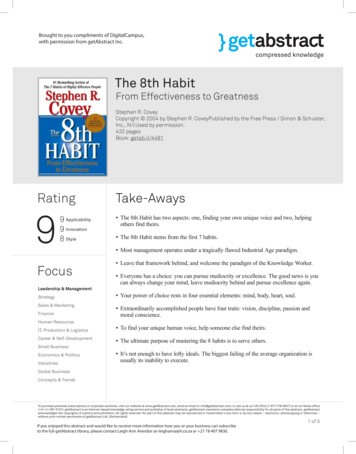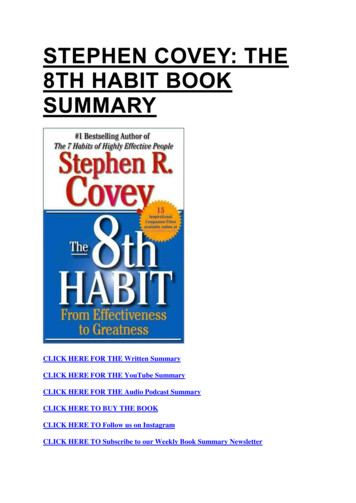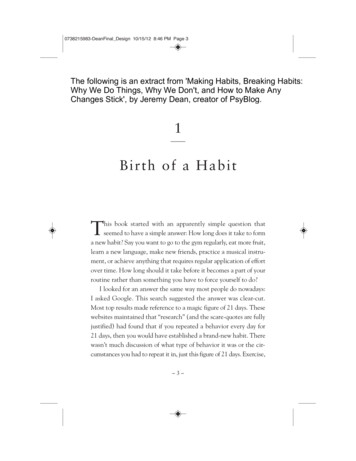
Transcription
0738215983-DeanFinal Design 10/15/12 8:46 PM Page 3The following is an extract from 'Making Habits, Breaking Habits:Why We Do Things, Why We Don't, and How to Make AnyChanges Stick', by Jeremy Dean, creator of PsyBlog.1Birth of a HabitThis book started with an apparently simple question thatseemed to have a simple answer: How long does it take to forma new habit? Say you want to go to the gym regularly, eat more fruit,learn a new language, make new friends, practice a musical instrument, or achieve anything that requires regular application of effortover time. How long should it take before it becomes a part of yourroutine rather than something you have to force yourself to do?I looked for an answer the same way most people do nowadays:I asked Google. This search suggested the answer was clear-cut.Most top results made reference to a magic figure of 21 days. Thesewebsites maintained that “research” (and the scare-quotes are fullyjustified) had found that if you repeated a behavior every day for21 days, then you would have established a brand-new habit. Therewasn’t much discussion of what type of behavior it was or the circumstances you had to repeat it in, just this figure of 21 days. Exercise,–3–
0738215983-DeanFinal Design 10/15/12 8:46 PM Page 4JEREMY DEANsmoking, writing a diary, or turning cartwheels; you name it, 21days is the answer. In addition, many authors recommend thatit’s crucial to maintain a chain of 21 days without breaking it. Butwhere does this number come from? Since I’m a psychologist withresearch training, I’m used to seeing references that would support a bold statement like this. There were none.My search turned to the library. There, I discovered a varietyof stories going around about the source of the number. Easily, myfavorite concerns a plastic surgeon, Maxwell Maltz, M.D. DrMaltz published a book in 1960 called Psycho-Cybernetics inwhich he noted that amputees took, on average, 21 days to adjustto the loss of a limb and he argued that people take 21 days toadjust to any major life changes.1 He also wrote that he saw thesame pattern in those whose faces he had operated on. He foundthat it took about 21 days for their self-esteem either to rise tomeet their newly created beauty or stay at its old level.The figure of 21 days has exercised an enormous power overself-help authors ever since. Bookshops are filled with titles likeMillionaire Habits in 21 Days, 21 Days to a Thrifty Lifestyle, 21Days to Eating Better, and finally, the most optimistic of all: 21Day Challenge: Change Almost Anything in 21 Days (at least it acknowledges that it might be a challenge!). Occasionally, the 21day period is deemed a little too optimistic and we are given anextra week to transform ourselves. These more generous titles include The 28-Day Vitality Plan and Diet Rehab: 28 Days to FinallyStop Craving the Foods that Make You Fat.Whether 21 or 28 days, it’s clear that what we eat, how wespend money, or indeed, anything else we do, has little in com–4–
0738215983-DeanFinal Design 10/15/12 8:46 PM Page 5MAKING HABITS, BREAKING HABITSmon with losing a leg or having plastic surgery. To take Dr Maltz’sobservations of his patients and generalize them to almost allhuman behavior is optimistic at best. It’s even more optimisticwhen you consider the variety amongst habits. Driving to work,avoiding the cracks in the pavement, thinking about sports, walking the dog, eating a salad, booking a flight to China; they couldall be habits and yet they involve such different areas of our lives.But, to be fair, Maltz didn’t invent the 21-day time frame; thereare all sorts of origin stories explaining its whereabouts, most ofthem standing on science-free ground.Thanks to recent research, though, we now have some ideaof how long common habits really take to form. In a study carriedout at University College London, 96 participants were asked tochoose an everyday behavior that they wanted to turn into ahabit.2 They all chose something they didn’t already do that couldbe repeated every day; many were health-related: people chosethings like “eating a piece of fruit with lunch” and “running for 15minutes after dinner.” Each of the 84 days of the study, theylogged into a website and reported whether or not they’d carriedout the behavior, as well as how automatic the behavior had felt.As we’ll soon see, acting without thinking, or “automaticity,” is acentral component of a habit.So, here’s the big question: How long did it take to form a habit?The simple answer is that, on average, across the participants whoprovided enough data, it took 66 days until a habit was formed.And, contrary to what’s commonly believed, missing a day or twodidn’t much affect habit formation. The complicated answer ismore interesting, though (otherwise, this would be a short book).–5–
0738215983-DeanFinal Design 10/15/12 8:46 PM Page 6JEREMY DEANOn average, habit formation took 66 days. Drinking a glass of waterreached maximum automaticity after 20 days; for 50 sit-ups, it tooklonger than the 84 days of the study.As you might imagine, there was considerable variation in howlong habits took to form depending on what people tried to do.People who resolved to drink a glass of water after breakfast were upto maximum automaticity after about 20 days, while those trying toeat a piece of fruit with lunch took at least twice as long to turn itinto a habit. The exercise habit proved most tricky with “50 situps after morning coffee,” still not a habit after 84 days for one participant. “Walking for 10 minutes after breakfast,” though, wasturned into a habit after 50 days for another participant.The graph shows that this study found a curved relationshipbetween repeating a habit and automaticity. This means that theearlier repetitions produced the greatest gains towards establish–6–
0738215983-DeanFinal Design 10/15/12 8:46 PM Page 7MAKING HABITS, BREAKING HABITSing a habit. As time went on these gains were smaller. It’s liketrying to run up a hill that starts out steep and gradually levelsoff. At the start you’re making great progress upwards, but thecloser you get to the peak, the smaller the gains in altitude witheach step. For a minority of participants, though, the new habitsdid not come naturally. Indeed, overall, the researchers were surprised by how slowly habits seemed to form. Although the studyonly covered 84 days, by extrapolating the curves, it turned outthat some of the habits could have taken around 254 days toform—the better part of a year!What this research suggests is that 21 days to form a habit isprobably right, as long as all you want to do is drink a glass ofwater after breakfast. Anything harder is likely to take longer tobecome a really strong habit, and, in the case of some activities,much longer. Dr Maltz and his cheerleaders weren’t even close,and all those books promising habit change in only a few weeksare grossly optimistic. Of course, this study opens up a whole newset of questions. The participants were only trying to adopt newhabits; what about our existing habits? How much better mightthey have done using tried and tested psychological techniques?And this study doesn’t really tell us what a habit feels like, howwe experience it, or where it tends to happen.–*–What do we actually do all day long? Some busy days slip by in aflash and we remember little. Whether at work or idling aroundat home, it would be fascinating to know exactly how our time is–7–
0738215983-DeanFinal Design 10/15/12 8:46 PM Page 8JEREMY DEANspent and which parts are habitual. Unfortunately, there’s a verygood reason why we tend to be awful at recalling habitual behavior, which is to do with its automaticity. So psychologists usediary studies, which give a much more accurate picture of whatpeople are up to than we can get from memory. In one study led byhabit researcher Wendy Wood, 70 undergraduates at Texas A&MUniversity were given a watch alarm.3 Every hour while they wereawake, it reminded them to write down what they were doing,thinking, and feeling, right at that very moment. The idea wasnot just to build up a list of activities, but to see the context inwhich they occurred. Across two separate studies, the researchersfound that somewhere between one-third and half the time, people were engaged in behaviors which were rated as habitual. Thissuggests that as much as half the time we’re awake, we’re performing a habit of one kind or another. Even this high figure maywell be an underestimate, since it’s based only on young peoplewhose habits haven’t had much of a chance to set hard.4So, what were participants in Wood’s research up to? Sincethey were students, the largest category was studying. This included attending classes, reading, and going to the library, whichmade up 32% of the diary entries. Amongst these activities, aboutone-third were classified as habitual. The next category was entertainment, which participants were engaged in 14% of the time.This included things like watching TV, using the Internet, andlistening to music. And this time, the percentage of habitual activities went up to 54%. Next on the list were social interactions,which made up 10% of the entries and 47% of which were classified as habitual behaviors. The category in which the behaviors–8–
0738215983-DeanFinal Design 10/15/12 8:46 PM Page 9MAKING HABITS, BREAKING HABITSwere least habitual was cleaning, down at only 21%, while thecategory which was most habitual was going to sleep and wakingup at 81% (at least they weren’t hiding their lazy, slovenly ways!).More important than precisely what they were doing (especially for those of us who aren’t students), are the characteristics ofhabits. What does it feel like? What’s going on in our minds?What emerged from this study, as it has from others, are threemain characteristics of a habit. The first is that we’re only vaguelyaware of performing them. Like when you drive to work and don’tnotice the traffic lights. You know some part of your mind was attending to them, along with other road-users and the speed limit,but you often can’t specifically remember doing so. In Wood’sstudy, participants reported exactly this vagueness about their habitual behavior. While they were hanging out, watching TV, orbrushing their teeth, they reported thinking about what they weredoing only 40% of the time. It’s one of the major benefits of ahabit: it allows us to zone out and think about something else, likeplanning a trip on the weekend. Habits allow the conscious part ofour minds to go a-wandering while our unconscious gets on withthose tedious repetitious behaviors. Habits help protect us from“decision fatigue”: the fact that the mere act of making decisionsdepletes our mental energy. Whatever can be done automaticallyfrees up our processing power for other thoughts.A habit doesn’t just fly under the radar cognitively; it also doesso emotionally. And this is the second characteristic thatemerged: the act of performing a habit is curiously emotionless.The reason is that habits, through their repetition, lose their emotional flavor. Like anything in life, as we become habituated, our–9–
0738215983-DeanFinal Design 10/15/12 8:46 PM Page 10JEREMY DEANemotional response lessens. The emotion researcher Nico Frijdaclassifies this as one of the laws of emotion and it applies to bothpleasure and pain.5 Activities we once considered painful, likegetting up early to go to work, become less so with repetition. Onthe other hand, activities which excite or give us pleasure initially, like sex, beer, or listening to Beethoven’s 7th, soon becomemundane. Of course, we fight against the leaking away of pleasure, sometimes with success, by seeking variety. This is why somepeople feel they have to keep pushing the boundaries of experience just to get the same high.None of this means we don’t feel emotion while performing ahabit, it’s just that the feelings we experience usually have less todo with the habit and more to do with where our minds havewandered off. Wood’s research found this exact pattern in participants’ reports of their emotional experience. Compared withnon-habitual behaviors, when people were performing habitstheir emotions tended not to change. In addition, the emotionsthat people did experience were less likely to be related to whatthey were doing than when their activities were non-habitual.The fact that habitual behavior doesn’t stir up strong emotions isone of its advantages. Participants in this study felt more in control and less stressed while performing habits than they did enacting non-habitual behaviors. The moment that participantsswitched to non-habitual behaviors, their stress level increased.The third important characteristic of a habit is so obvious thatwe often don’t notice it. Perhaps this is partly a result of the automatic nature of habits. Take some typical daily routines: Youget up in the morning, go to the bathroom, and take a shower . . .– 10 –
0738215983-DeanFinal Design 10/15/12 8:46 PM Page 11MAKING HABITS, BREAKING HABITSLater you’re in the car when you turn on your favorite radio station . . . Then, at the coffee shop, you order a blueberry muffin . . .The connection is context. We tend to do the same things in thesame circumstances. Indeed, it’s partly this correspondence between the situation and behavior that causes habits to form inthe first place.The idea that we create associations between our environment and certain behaviors was memorably demonstrated by theRussian physiologist, Ivan Pavlov. In Pavlov’s most famous research, carried out on dogs, he created an association betweenbeing fed and a ringing bell. Then, after a while, he tried ringingthe bell without feeding the dog. He noticed that the dog beganto salivate anyway. The bathroom, car, and coffee shop are likePavlov’s bell, unconsciously reminding us of long-standing patterns of behavior, which we then enact again, in exactly the sameway as before. T
MAKING HABITS, BREAKING HABITS 0738215983-DeanFinal_Design 10/15/12 8:46 PM Page 5. As you might imagine, there was considerable variation in how long habits took to form depending on what people tried to do. People who resolved to drink a glass of water after breakfast were up to maximum automaticity after about 20 days, while those trying to eat a piece of fruit with lunch took at
